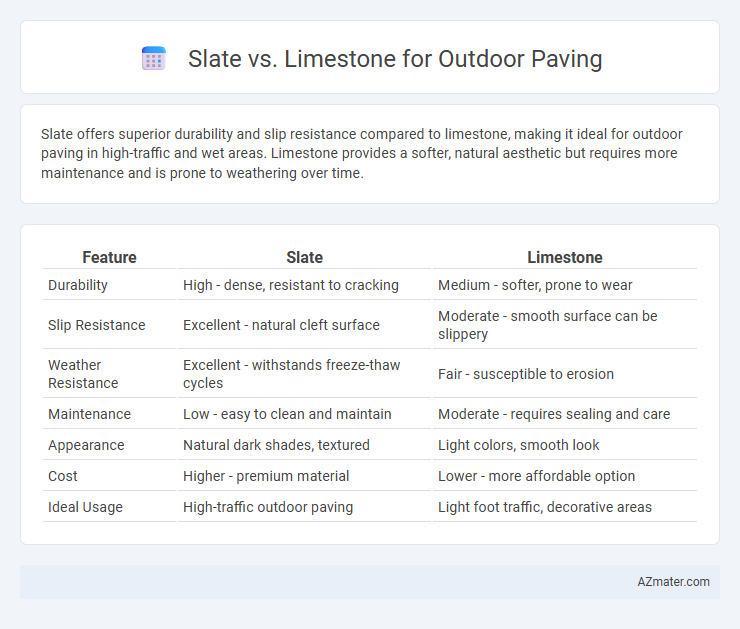Slate offers superior durability and slip resistance compared to limestone, making it ideal for outdoor paving in high-traffic and wet areas. Limestone provides a softer, natural aesthetic but requires more maintenance and is prone to weathering over time.
Table of Comparison
| Feature | Slate | Limestone |
|---|---|---|
| Durability | High - dense, resistant to cracking | Medium - softer, prone to wear |
| Slip Resistance | Excellent - natural cleft surface | Moderate - smooth surface can be slippery |
| Weather Resistance | Excellent - withstands freeze-thaw cycles | Fair - susceptible to erosion |
| Maintenance | Low - easy to clean and maintain | Moderate - requires sealing and care |
| Appearance | Natural dark shades, textured | Light colors, smooth look |
| Cost | Higher - premium material | Lower - more affordable option |
| Ideal Usage | High-traffic outdoor paving | Light foot traffic, decorative areas |
Introduction to Slate and Limestone Outdoor Paving
Slate and limestone are popular choices for outdoor paving due to their durability and aesthetic appeal. Slate offers a natural cleft surface with excellent slip resistance and rich, dark tones, making it ideal for patios and walkways that demand elegance and safety. Limestone provides a softer, textured finish with lighter hues and excellent weather resistance, perfect for creating a warm, inviting outdoor space that withstands varying climates.
Key Physical Characteristics: Slate vs Limestone
Slate offers a dense, fine-grained texture with natural cleft surfaces that provide excellent slip resistance and durability for outdoor paving. Limestone features a softer, porous composition with smooth, matte finishes that can weather more quickly and require sealing to prevent staining. Slate's higher hardness and resistance to frost make it ideal for high-traffic, exposed areas, while limestone's lighter colors and softer feel suit decorative, low-traffic applications.
Aesthetic Appeal and Color Variations
Slate offers a rich, natural texture with deep, earthy tones ranging from gray and black to rust and green, providing a sophisticated and rustic aesthetic ideal for outdoor paving. Limestone features a softer, more uniform appearance with subtle cream, beige, and light gray hues that enhance outdoor spaces with a timeless, elegant charm. Both materials provide diverse color variations that allow for versatile design options, but slate's pronounced veining and texture create a more dramatic visual impact compared to limestone's understated, smooth finish.
Durability and Weather Resistance Comparison
Slate offers exceptional durability and weather resistance for outdoor paving due to its dense, fine-grained structure that withstands freeze-thaw cycles and heavy foot traffic without significant wear. Limestone, while attractive and easier to cut, tends to be more porous and vulnerable to acid rain and frost damage, reducing its longevity in harsh climates. Choosing slate ensures superior resilience against moisture, temperature fluctuations, and erosion, making it ideal for long-lasting outdoor surfaces.
Surface Texture and Slip Resistance
Slate offers a naturally cleft surface with a textured finish that enhances slip resistance, making it ideal for outdoor paving in wet or icy conditions. Limestone typically has a smoother, honed surface that may become slippery when wet, requiring additional treatment or sealants for improved traction. The dense composition of slate generally provides better durability and consistent grip compared to limestone's softer, more porous structure.
Installation Process and Maintenance Needs
Slate outdoor paving requires careful installation with a solid, well-drained base to prevent moisture retention and potential cracking, often necessitating professional expertise due to its natural variations and split layers. Limestone installation typically involves a compacted base of sand or gravel, with easier handling due to its uniform texture, making DIY projects more feasible. Maintenance for slate includes resealing every few years to preserve its durability and appearance, while limestone demands regular cleaning to avoid staining and periodic sealing to protect against weathering and erosion.
Cost Analysis: Slate vs Limestone
Slate outdoor paving typically costs between $10 and $30 per square foot, reflecting its durability and natural cleavage, while limestone ranges from $3 to $15 per square foot, offering a more budget-friendly option with versatile aesthetics. Installation expenses for slate are often higher due to its density and weight, requiring specialized labor, whereas limestone's softer texture allows for easier cutting and faster installation, reducing labor costs. Maintenance for both materials influences long-term investment, with slate demanding periodic sealing to preserve its rich tones and limestone requiring routine cleaning to prevent staining and erosion, impacting overall cost efficiency.
Eco-Friendliness and Sustainability Factors
Slate offers high durability and low porosity, making it a long-lasting, eco-friendly choice for outdoor paving by reducing the need for frequent replacement. Limestone, a sedimentary rock, is more porous and softer, which can lead to faster wear and higher maintenance, potentially impacting sustainability negatively. Both materials are natural stones with recyclable properties, but slate's longer lifespan contributes to a lower environmental footprint over time.
Best Applications for Slate and Limestone Pavers
Slate pavers excel in outdoor applications requiring a highly durable, non-slip surface, making them ideal for patios, walkways, and pool surrounds due to their natural cleft texture and resistance to weathering. Limestone pavers are best suited for areas that benefit from their soft, warm appearance and uniform texture, commonly used in garden paths and courtyards where a smoother, more refined look is desired. The choice between slate and limestone paving depends on the specific outdoor environment, climate conditions, and aesthetic preferences, with slate favored for rugged durability and limestone preferred for classic elegance.
Conclusion: Choosing the Right Stone for Your Outdoor Space
Slate offers superior durability and a non-slip surface, making it ideal for high-traffic outdoor paving areas requiring long-lasting performance. Limestone, characterized by its softer texture and lighter color palette, provides an elegant aesthetic but may require more maintenance due to its susceptibility to weathering and staining. Selecting between slate and limestone depends on balancing durability needs, visual preferences, and maintenance commitment for your specific outdoor environment.

Infographic: Slate vs Limestone for Outdoor Paving
 azmater.com
azmater.com